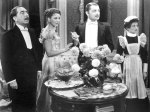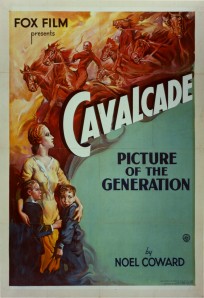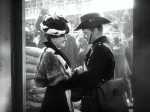Frank Lloyd’s Cavalcade, the rarely aired and distributed Academy Award Best Picture-winner of 1933, fares quite well nearly eighty years after its original release. Like many other literary adaptations and prestige films from Classic Hollywood (this being an adaptation of Noël Coward’s 1931 stage play), the film suffers from some typical pitfalls of early sentimental films. Modern viewers would be likely to critique it’s exaggerated melodramatic acting, theatrically-blocked mise-en-scène, and sometimes unfocused ensemble plotting. Nevertheless, this story of one British family’s endurance over the numerous obstacles of the early twentieth century remains substantial well into the twenty-first century.
Like a vintage version of Downton Abbey, Cavalcade chronicles the stories of the Marryots and the Bridges, their servants, from New Year’s Eve 1899 to that of 1929. Across these thirty years, which include some of England’s greatest trials and triumphs from the Boer Wars of South Africa and the death of Queen Victoria to the sinking of Titanic and World War I, the two families experience the inevitable diffusion of wealth and devastation across socio-economic borders. The Bridges, eventually opening a bar and raising a prodigiously talented daughter, rise in rank and soon equal the Marryots in the new twentieth century social structure. The Marryots, however, are humbled by the great effects of war, the loss of family, and the increasingly “loose” morals of the emergent society.
Ultimately, Cavalcade offers a message much like those of Goodbye, Mr. Chips (1939) and Mrs. Miniver (1942) from later in the following decade: Supplying an epic narrative of Englishmen’s capabilities to survive, it asserts that Britain has been and always will be a dominant, superior culture. This attitude was common in American cinema of the 1930s, as literary adaptations and British subject matter provided an air of sophistication to the burgeoning popular art form.

(Left to Right) Herbert Mundin, Diana Wynyard, Clive Brook, and Una O’Connor make up a talented ensemble.
The combination of the film’s blatant place in this canon of uncontested, biased British politic with its unbalanced blend of genre (traipsing from ensemble drama to wartime epic to melodrama with hints of social issue and semi-doc) ages Cavalcade and targets its inaccessibility to today’s much more cynical audience. Nevertheless, the film deserves praise for the tenacity of its scope and success of its execution at an early stage in sound cinema. Moments of striking three-dimensional camera movement between theatrically-staged sequences stand out for enhancing the scale of the astoundingly-dressed and -peopled sets. And even within the obvious chronology of iconic historical events, Lloyd is able to direct numerous sequences that shock and evoke based on character arc and emotion.
Cavalcade may not amuse many contemporary audiences; but in its act of documenting and humanizing recent history, the film itself serves as a fascinating document of how cinema, the world’s most popular artistic medium, even through fiction has been chronicling and establishing history for 119 years.


